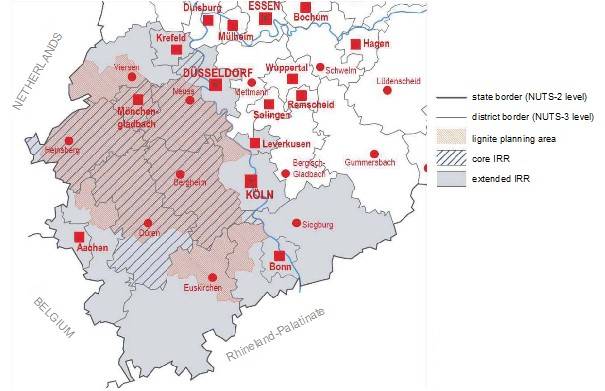25. June 2021What Makes a Region?
Defining a region is always challenging and often contested. This is particularly true if the borders of the region determine who gets to decide and who gets access to resources. This blog post sheds some light on the different dimensions of regionality and how a more nuanced understanding of “region” can support decarbonization and structural adjustments.
The term “region” is common in everyday language, but very tricky to define scientifically. Of course, if you are studying carbon-intensive regions in transition, you have to have a clear definition of your unit of analysis. The challenge is that regions are not a natural feature but a social construct. And this social construction can rest on a range of different dimensions.
If we are talking about decarbonization in carbon-intensive regions, we define a policy region. The borders of the policy region are defined by the geographic area in which the very carbon-intensive industries are located which are the subject of decarbonization policies.
Of course, decarbonization policies are usually tied to specific jurisdictions. However, these administrative regions do not necessarily conform to the policy region. In many cases, the policy region spans beyond administrative borders causing additional challenges to managing the transition. What is the adequate governance level to manage decarbonization policies and subsequent structural adjustments if the policy region cuts across several jurisdictions? This can lead to conflict between competing governments, both horizontally, i.e. between governments on the same level of hierarchy (e.g. district governments), as well as vertically between different levels of government (e.g. district and state/provincial governments). Intermediaries such as regional development agencies can help to overcome rivalries and improve coordination.
In economic geography, functional regions are often defined as organizational structures of economic activity. A prototypical functional region would be a major urban centre which serves as a service centre or point of supply for a hinterland which in turn serves as market area for the urban core. Another example would be urban regions with several centres such as the German Ruhr Area or the Upper Silesian Metropolis.
Finally, regions can be constructed on the basis of relatively homogenous and cohesive natural or cultural features, a common “form”. These formal regions can relate, for example, to natural landscapes, ethnical composition, language or other ’cultural realms’ that contribute to a distinct regional identity.
These regional dimensions may or may not overlap. This is nicely illustrated by the example of the Rhenish mining area shown in the Figure. The area shaded in red is the lignite planning area, i.e. the area in which mining law permits planning for lignite mining activities. However, that area exceeds the area in which mining activities actually take place. Hence the policy region has been defined as what is depicted as the core “Innovationsregion Rheinisches Revier“ (IRR) (innovation region Rhenish mining area) consisting of five administrative regions at the district level (Kreis Düren, Kreis Heinsberg, Rhein-Erft-Kreis, Rhein-Kreis Neuss, Stadt Mönchengladbach)[1] and covering parts of two regions that are one level higher in the administrative hierarchy (Regierungsbezirk Köln and Regierungsbezirk Düsseldorf).
In terms of functional regions, the Rhenish mining area is located at the margins of three major nodal regions with their cores in Düsseldorf, Cologne (Köln) and Aachen. In terms of formal regions, the mining area again sits on the margins of two landscape units (Kölner Bucht and Niederrheinische Tiefebene) both of which by far exceed the core mining area. Culturally, the closest comparison to a cohesive and homogenous region would be the Rhineland which also by far exceeds the core policy region.

Figure 1: Statistical definition of the Rhenish lignite mining area (“Innovationsregion Rheinisches Revier” – IRR).
Source: adapted from Regionomica (state of play 2013)
This example illustrates the various ways in which a region can be constituted and defined. It illustrates that regions as units of analysis can vary greatly in the degree to which the various aspects of regionalization overlap. The larger the overlap, the higher the “institutional thickness” of a region. For the purpose of the analysis of structural change in carbon-intensive regions it is critical to pay close attention to these aspects. They shape the ways in which carbon-intensive regions may resist decarbonization pressures, or embrace them and adapt proactively to the imminent structural changes.
Recommendations for further reading:
- Paasi, A. (2009). The Resurgence of the ‘Region’ and ‘Regional Identity’: Theoretical Perspectives and Empirical Observations on Regional Dynamics in Europe. Review of International Studies, 35, 121–146. https://doi.org/10.1017/S0260210509008456
- Parr, J. B. (2014). The Regional Economy, Spatial Structure and Regional Urban Systems. Regional Studies, 48(12), 1926–1938. https://doi.org/10.1080/00343404.2013.799759
Author
Dr. Lukas Hermwille
Senior Researcher
Wuppertal Institute
Global Climate Governance Research Unit